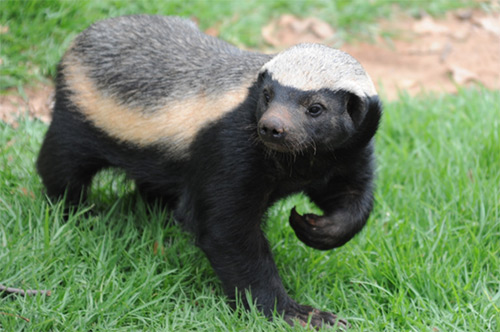IELTS HOPECO Reading: Unit 5 - Animal World (WB 4-5.5)
Reading 1
1. Quickly read the passage on the right and answer these questions.
…………………………………………………………………
2 What do they look like?
…………………………………………………………………
3 Why is 'honey badger' not a good name for this animal?
…………………………………………………………………
2. Read Questions 1-8 below.
2 Decide what type of information you need for each gap.
Questions 1-8
- Although they are not big animals, honey badgers are fearless, ………… and tough.
- Honey badgers will attack …………if they need to protect themselves.
- The pattern and colours on the honey badger's back make it …………
- The food they eat is meat-based and …………
- ………… form the biggest part of a honey badger's diet.
- Honey badgers find the creatures they eat by their …………
- ………… are often used to catch honey badgers which attack beehives.
- For one particular type of food, the honey badger has a …………with another creature.
 The honey badgerIt looks harmless and vulnerable. But the honey badger is afraid of nothing... and will attack and eat almost anything
The honey badger (Melivora capensis), is an African and south-Asian mammal that has a reputation for being one of the world's most fearless animals, despite its small size. And in spite of its gentle-sounding name, it is also one of its most aggressive. Honey badgers have been known to attack lions, buffalo, and snakes three times their size. Even humans are not safe from a honey badger if it thinks the human will attack or harm it. They are also extremely tough creatures, and can recover quickly from injuries that would kill most other animals. At first glance, honey badgers look like the common European badger. They are usually between 75cm and 1 metre long, although males are about twice the size of females. They are instantly recognisable by grey and white stripes that extend from the top of the head to the tail. Closer inspection, which is probably not a wise thing to do, reveals pointed teeth, and sharp front claws which can be four centimetres in length. Honey badgers are meat-eating animals with an extremely varied diet. They mainly eat a range of small creatures like beetles, lizards and birds, but will also catch larger reptiles like snakes and small crocodiles. Some mammals, such as foxes, antelope and wild cats also form part of their diet. The badgers locate their prey mainly using their excellent sense of smell, and catch most of their prey through digging. During a 24-hour period, they may dig as many as fifty holes, and travel more than 40 kilometres. They are also good climbers, and can easily climb very tall trees to steal eggs from birds' nests, or catch other tree-dwelling creatures. As their name suggests, honey badgers have always been associated with honey, although they do not actually eat it. It is the highly nutritious bee eggs (called 'brood') that they prefer, and they will do anything to find it. They usually cause a lot of damage to the hive in the process, and for this reason, humans are one of their main predators. Bee-keepers will often set special traps for honey badgers, to protect their hives. One of the most fascinating aspects of the honey badger is its working relationship with a bird called the greater honeyguide (Indicator indicator). This bird deliberately guides the badger to beehives, then waits while the badger breaks into the hive and extracts the brood. The two creatures, bird and mammal, then share the brood between them. |
3. Now complete Questions 1-8. Write NO MORE THAN TWO WORDS from the passage for each answer.
Reading 2
Pick from a list
4. You are going to read more about the honey badger. Before you do this, look at the exam question in the box and answer the questions1-4.
|
1 Why did the wildlife experts visit the Kalahari desert? Choose two reasons. |
-
Underline the key words in the question.
-
Find the paragraph in the passage where the question is dealt with.
-
Now look at these five options for the question above. Look for the answers in the text. Delete three answers which are NOT possible.
-
Which two options are you left with? ………… and …………
|
5. Read the rest of the passage and choose TWO letters, A—E, for Questions 2-5.
Questions 2-5| 2. What two things does Kitso Khama say about honey badgers? A. They show interest in things they are not familiar with. B. It's hard to tell how they will behave. C. They are always looking for food. D. They do not enjoy human company. E. It is common for them to attack people. 3. What two things did the team find out about honey badgers? A. There are some creatures they will not eat. B. They were afraid of poisonous creatures. C. They may get some of the water they need from fruit. D. They do not always live alone. E. Female badgers do not mix with male badgers. 4. According to the passage, which of these two features are typical of male badgers? A. They don't run very quickly.B They hunt over a very large area. C. They defend their territory from other badgers. D. They sometimes fight each other. E. They are more aggressive than females. 5 What two things happened when the honey badgers got used to humans being around them? A. The badgers lost interest in people. B. The badgers became less aggressive towards other creatures. C. The badgers started eating more. D. Other animals started working with the badgers. E. Other animals near them became more relaxed. |
Mọi thông tin chi tiết, các bạn vui lòng liên hệ:
DU HỌC UNIGLOBE
10/3 Nguyễn Thị Minh Khai, Phường Đa Kao, Quận 1, TP.HCM
ĐT: (08) 35 173 345 – 35 173 678
Email: info@uniglobe.edu.vn
Website: www.uniglobe.edu.vn


.jpg)




bình luận